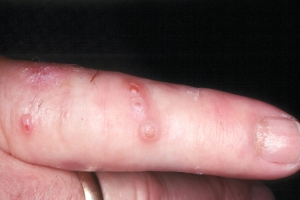Farmyard Pox consists of Orf and Milker’s Nodules, two paramyxoviruses that have very similar clinical features, which I encounter in my The Woodlands dermatology and Conroe dermatology offices. The clinical and histological findings in both Orf and Milker’s nodules are identical so they are differentiated based on a patient’s clinical history. Orf, also called Ecthyma Contagiosum, is due to direct contact with infected sheep but can also be transmitted through fomites (objects the virus has made contact with) as Orf is a very sturdy virus, but human to human transmission is rare. Orf typically appears one week after exposure and begins as a solitary papule that develops a target like lesion. A nodule soon develops, which may have discharge and exudate that ultimately forms a crusted plaque before healing over a 6 week period. Usually, no residual scarring or dyspigmentation remains. No treatment is needed but a shave removal of the Orf lesion can hasten resolution. In 5% of patients with Orf, an erythema multiforme like eruption can occur. Milker’s nodules, also called Bovine Papular Stomatitis, is transmitted from the udders or muzzles of infected cows. The clinical features are identical to Orf as well as the treatment.





